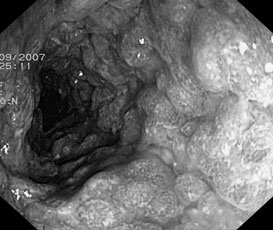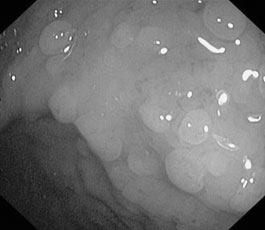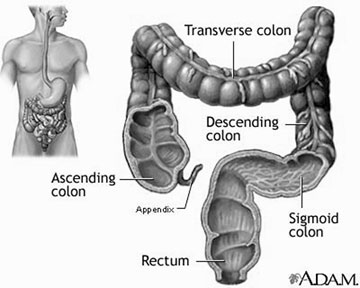|

Rectal cancer display same symptoms as haemorrhoids:
The silent killer
by Sajitha PREMATUNGE
Initially painless but fatal if diagnosed late, rectal cancers are a
silent killer. Rectal cancers are a hidden disease often overlooked due
to painlessness. Of patients with rectal cancer in over 90% are
diagnosed after the age of 50.
 |
|
Consultant General
Surgeon Dr. C.K. Pathirana |
The condition is not common among the young and the middle aged. Last
week we talked about anal fissures in Healthwise. The condition
discussed this week depicts several of the symptoms depicted by anal
fissures and piles. According to Consultant General Surgeon Dr. C.K.
Pathirana, a major reason for cases of delayed diagnosis is that
symptoms of this potentially fatal condition are often confused with
that of haemorrhoids or piles.
Symptoms
Symptoms of this condition include bleeding, recent alteration in
bowel habits such as having too many or less motions a day, stools
getting narrower, passing of flatus more often, weakness, loss of weight
and bloating or abdominal distension. Bloating and abdominal distension
are also symptoms of gastritis and therefore there is a rare chance of
misdiagnosis.
According to Dr. Pathirana bleeding in these patients may occur at
the beginning or at the end of a motion, as fresh blood or altered or
dark blood mixed with stools or clots mixed mucous. “Even if they have a
motion patients suffering from rectal cancer feel as if they have
defecate again...” explained Dr. Pathirana “in which case they may pass
blood or mucous.”
In the worst case scenario bleeding can go completely unnoticed. If a
patient suffering from continuous bleeding does not seek medical
attention, loss of blood can leave the patient looking pale, “which is
one of the first signs doctors look for.”
|
 |
|
Rectal cancer |
|
 |
|
Inflamatory bowel
disease |
|
 |
|
Polyps |
Patients become emaciated and, according to Dr. Pathirana, often have
to be admitted to the ER with long duration constipation, vomiting and
loss of appetite - which is a result of the disease spreading to other
organs and the stomach - all symptom of advanced rectal cancer. “Most
patients are old people neglected by themselves and often rest of the
family.” As Dr. Pathirana explained the entire combination of symptoms
mentioned may not be seen in one patient.
Because pain does not set in until the advance stage of the disease
patients put off seeking medical attention. A delay in diagnosis in the
case of rectal cancer can be fatal. “Another major reasons for the
disease going unnoticed is that most patients come to their own
diagnosis that they are suffering from piles, since many of the symptoms
are similar for both conditions”, explained Dr. Pathirana. “If you have
the symptoms mentioned the best thing is not come to a diagnosis on your
own,” warned Consultant General Surgeon, Dr. C.K. Pathirana.
Causes
Dr. Pathirana explained about people with polyps - a protrusion on
the inner lining of the rectum or any other part of the gastro
intestinal tract. “Some polyps are benign, but some can become cancers”
explained the doctor. “Even patients with benign polyps are more
vulnerable to rectal cancers than the average person.” Moreover,
inherent conditions when patients develop multiple polyps are most
vulnerable.
* Lifestyle - people taking a low fibre - less fruits and vegetable -
high fat - rich in animal fat - diet are most susceptible while less
physical activity and smoking can also make a person vulnerable to this
form of cancer.
* Family history - there may be a high probability of a patient
developing rectal cancer, whose first degree relatives - father, mother
or siblings - have been previously diagnosed with the disease. Genetic
mutations can also render people vulnerable to this disease.
* Other diseases - inflammatory bowel disease, which involves the
ulceration of the whole colon - which occur in younger people - is
another cause of rectal cancer.
Diagnosis
“If any of the rectal cancer symptoms are depicted by a patient
doctors conduct a simple day procedure called the DRE (Digital Rectal
Examination) where the doctor puts his finger inside the rectum to feel
any palpable growth” explained Dr. Pathirana. If there is such a
palpable growth a biopsy is conducted - where tissue from the growth is
extracted to confirm diagnosis. “Such growths could involve part of the
rectum or the entire circumference.”
If there is no palpable growth, it is mandatory to conduct an
endoscopic evaluation or colonoscopy and a biopsy after testing the
patient’s haemoglobin level count and taking a ‘stools for occult blood
test’. “If a certain patient is not fit for a colonoscopy we will
conduct what is referred to as a ‘Double contrast barium enema’”
explained the doctor. This is a screening process which involves the
introduction of a gas and a liquid through the rectum - to distend the
colon - and subjecting the patient to something like a video X ray.
Depending on the degree of the disease ultrasound or CT scans of the
abdomen may be required to determine whether it has spread to other
organs.
Treatment
Depending on the stage of the disease different methods of treatment
is taken by doctors. If it is diagnosed in the early stage, when it is
just confined to the inner lining of the rectum, the tumour can be
removed endoscopically. “If it is in the intermediate stage, where it
has spread to the muscle layer, the part of the rectum must be removed
along with the tumour” explained the doctor. “One of the principles of
cancer surgery is not to leave any cancer cells to avoid a patient from
going into remission.” Consequently a considerable amount of tissue from
either side has to be removed along with the tumour.
“But because the rectum is the last part of the elementary cannel
doctors have to take into consideration whether the tumour can be
removed with a safe margin of clearance.” If the rectum cannot be
securely reconnected after surgery stools may leak into the abdomen,
which can be fatal. “Because of the dangerous nature of this surgery the
rectum needs sufficient time to recuperate” said Dr. Pathirana. A
temporary colostomy - where the colon is repositioned so that the stools
can be defecated from the side of the abdomen with the help of a
catheter - allows the healing period necessary for the rectum.
 If the tumour is too close to the edge of the rectum, and too close
to the anus, it may not be possible to remove enough tissue from either
side of the anus to avoid remission without losing the anus. “In such
cases the patient has to undergo a permanent colostomy.” If the tumour is too close to the edge of the rectum, and too close
to the anus, it may not be possible to remove enough tissue from either
side of the anus to avoid remission without losing the anus. “In such
cases the patient has to undergo a permanent colostomy.”
The patient can be subjected to radio and chemo therapy before or
after surgery, depending on the stage of the disease.
Reducing risks
It is important to maintain a healthy lifestyle to avoid any kind of
disease. The same goes for rectal cancers.
“Add more fruits (preferably fresh fruit) and vegetables to your
diet, exercise regularly and cut down on animal fat”, suggested Dr.
Pathirana.
If you see any of the symptoms mentioned please seek medical
attention. “If you have polyps in the rectum get them removed.”
And if any of your immediate relatives have been diagnosed with
rectal cancer it is always safe to get a genetic screening.
Toxic paints, a health hazard
by Jayampathy JAYASINGHE
Has anyone thought for a moment about the safety of paints used
widely in our bedroom walls and toys that our children play with all the
time? A global study conducted by Dr. Abhay Kumar of India in 2009 has
shed light on the hazardous use of toxic paints that people use in
developing countries. People are ignorant of such hazardous paints being
used in their households. Dr. Kumar’s study on lead was conducted in ten
countries including Sri Lanka, Philippines, Thailand, Tanzania, South
Africa, Nigeria, Senegal, Belarus, Mexico, Brazil and India.
Many Studies have revealed that lead, a toxic substance was being
widely used by paint manufacturers all over the world. His findings were
published in a report by the International Pops Elimination Network (IPEN).
It states that lead paint was used by millions of people all over the
world to paint their walls, toys etc. According to the World Health
Organisation (WHO) lead, has had an impact on 40 million children
worldwide. Paint companies add lead to improve the sheen, durability and
colour of their products.
 The report further states that the paint industry knew for more than
a half a century the use of lead, was a health hazard. As early as 1935,
the European countries banned the use of lead in household paints. The
United States banned it in 1971. It was proven that lead lowers the IQ
and causes other complications as well. The report states that all paint
manufacturers in India use lead except for one major manufacturer. A
huge outcry in the US and in Europe erupted when it became apparent that
lead was used in the manufacture of toys, lead-based paint in older
houses was known to be associated with elevated levels of blood in
children. The report further states that the paint industry knew for more than
a half a century the use of lead, was a health hazard. As early as 1935,
the European countries banned the use of lead in household paints. The
United States banned it in 1971. It was proven that lead lowers the IQ
and causes other complications as well. The report states that all paint
manufacturers in India use lead except for one major manufacturer. A
huge outcry in the US and in Europe erupted when it became apparent that
lead was used in the manufacture of toys, lead-based paint in older
houses was known to be associated with elevated levels of blood in
children.
Dr. Abhay Kumar conducted his study on 317 paint samples.They were
analysed during November 2008 to February 2009 and found that majority
of enamel paint had lead concentration higher than 90 Parts Per Million
(PPM) or 600 PPM. The study also found that there was a general lack of
awareness on the issue of lead by majority countries. The report states
that in the absence of any mandatory standards big and small, companies
continue to make use of lead without caring for environmental and health
hazards.
The Acting Director of the Central Environmental Authority (CEA)
Sarojini Jayasekera said that some common sources of lead that we come
across in our day to day life are enamel, bases paints in houses
batteries used in vehicles, toys, etc.
There is a high risk of exposing children to lead from toys and
ingesting and degraded paints.
The exposure to lead can be diverse and multiple with respect to
human health and environment. She said lead has no biological utility
and is hard to eliminate from the body. It could have an adverse effect
on the human body. Children are particularly more vulnerable to the lead
exposure. The toxicity of lead often depends on the blood levels. The
lowest toxic range influences intelligence, hearing, growth and
pregnancy.
The CEO of Akzo Nobel Paints Lanka (Pvt) Ltd, Gerald de Saram said at
a media briefing recently that an international report on paints
covering several countries were published in India. The report deals
exclusively with lead in decorative paints used in households.
He said people who come in contact with decorative paints should be
careful when they use such products. However, the paints manufactured by
them contained less lead, according to the IPEN.
The CEO said strict regulations governing the paint industry was a
pre-requisite. “I propose a partnership be set up with NGO’s, businesses
and the regulatory authority on the management of toxic materials.
“It was scary using paints with a high percentage of lead. The issue
is whether we are able to manage lead to conform to safety standards.
Lead is a toxic substance that affects the children who are vulnerable.
Studies have found that it also affects the reproductive process of the
adults. Persons who come into contact with lead from paints and from
automobile fuel emissions etc. Pharmaceutical, paints and even the food
industry contain such chemicals. “We have to use them carefully and
sensibly,” he said.
The CEO Saram said they have done away with the wood preservative
business despite being the market leader in Sri Lanka. “It is because it
was harmful to our stakeholders and to customers as well. Profit should
not come to us at the cost of hurting our customers as well.”
He said some of the chemicals used in the paint industry were
extremely dangerous. The Western companies were more sensitive to this
problem than their Asian counterparts when it comes to quality
standards.
Meanwhile, the IPEN report said that the paint industry in Sri Lanka
comprises 30 large and small players.
Some were well known companies for strong brands. According to the
Census and Statistics Department around 100 paint companies operated in
2003, declined to 60 in 2004.
The IPEN report states that the highest concentration of lead was
found in enamel paint samples. However, one paint company viz. ICI had
lead levels less than 90 ppm in both enamel and emulsion samples.
Weight gain contributes to breast cancer risks
by Madeline ELLIS
If you were to do a little time travelling, flashing back to when you
were 18, how would your weight differ from what it is today? According
to research by the American Cancer Society, the amount of weight a woman
gains after the age of 18 is a strong indicator as to whether she will
get breast cancer later in life.
Weight gain and body mass were identified long ago as risk factors
for breast cancer. The Cancer Society estimates between one-third and
one-half of all breast cancer deaths among older women have been
contributed to weight.
Fat tissue makes estrogen, and estrogen can help breast cancer grow.
 Heather Spencer Feigelson, senior epidemiologist with the American
Cancer Society said, “Breast cancer is strongly dependent on body
weight. Even modest amounts of weight gain lead to a significantly
increased risk of breast cancer.” Heather Spencer Feigelson, senior epidemiologist with the American
Cancer Society said, “Breast cancer is strongly dependent on body
weight. Even modest amounts of weight gain lead to a significantly
increased risk of breast cancer.”
One of the largest studies of breast cancer and weight included 1,934
breast cancer cases among 62,756 women involved in a separate long-term
study. Women ages 50 to 74, who were post-menopausal, were asked their
weight in 1992 when the study began and their weight when they were 18
years old. They were also sent questionnaires at yearly intervals.
The researchers said older women who gained 20 to 30 pounds after
high school graduation were 40 percent more likely to get breast cancer
than women who kept the weight off. If the weight gain was more than 70
pounds, the risk was doubled. Lean post-menopausal women not taking
hormone replacement therapy produce very little estrogen and had the
lowest cancer risk in the study.
Associate professor of surgery at Columbia University, Dr. Paul
Tartter said, “The more fat you have-fat cells are capable of
synthesising estrogen-the heavier you are, the higher your estrogen
levels. There’s no question that estrogen is the common denominator of
most of our risk factors for breast cancer.”
A study published in the Archives of Internal Medicine suggests that
weight gain throughout adulthood is linked to an increased risk of
developing breast cancer after menopause for women who do not undergo
menopausal hormone therapy. Scientists already knew that being
overweight or obese increased breast cancer risks after menopause, but
the correlation between the timing and the amount of weight gain in
adulthood had not been investigated before.
The study showed the importance of the timing of when the weight gain
occurred. Women who put on more than 66 pounds between the ages of 18
and 35 had a 65 percent higher risk, but those whose weight increased by
the same amount between 35 to 50 had a 223 percent higher risk of
developing breast cancer after menopause.
The results of these studies appear to confirm that putting more
estrogen into the body increases the risk of breast cancer for older
women, whether the estrogen comes from hormone therapy or from being
overweight. The postmenopausal women at the lowest risk seem to be the
ones with the lowest levels of estrogen, who do not use menopausal
hormone therapy, and who stay lean.
- Healthnews
|

